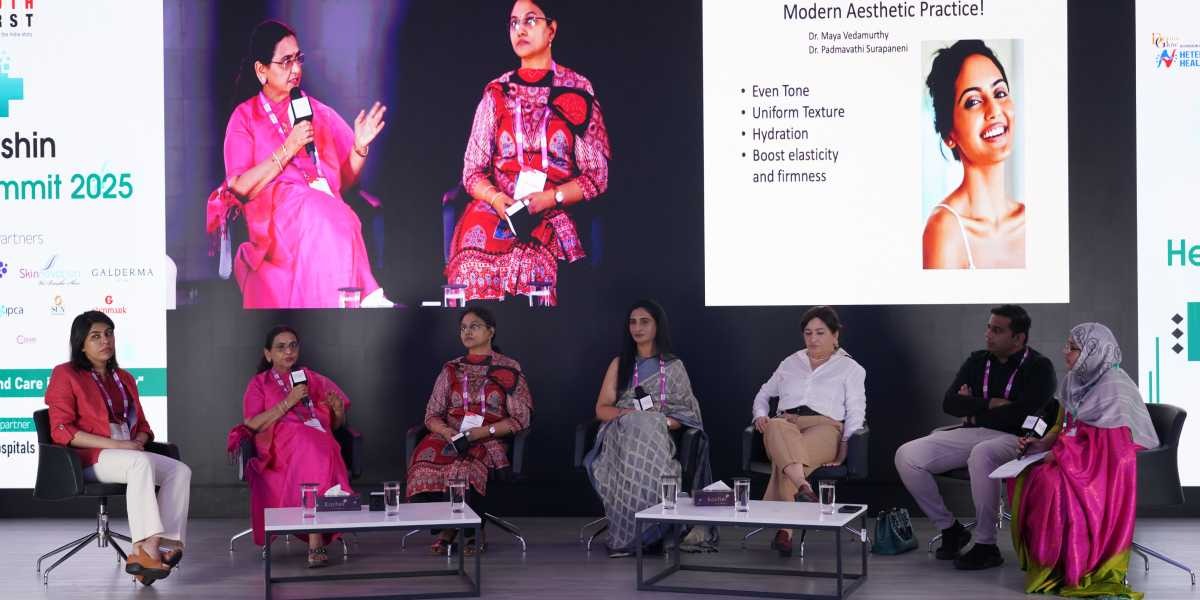Firmness and support become important as patients enter their 30s and 40s, requiring attention to collagen and skin elasticity.
Published Nov 16, 2025 | 8:00 AM ⚊ Updated Nov 16, 2025 | 11:04 AM

Expert panel speaking at the second edition of Dakshin Health Summit 2025.
Synopsis: At Dakshin Health Summit 2025, leading dermatologists demystified aesthetic treatments – Botox relaxes muscles, fillers restore volume. Both will yield natural results when dosed properly. Experts stressed on patient education, “baby Botox,” and “less is more” with fillers. These days, focus has shifted from fairness to the four pillars – even tone, texture, hydration, firmness – using skin boosters, exosomes, and regenerative therapies for subtle, individualised glow.
For many, words like Botox, fillers, or glutathione evoke curiosity, fear, or even skepticism. Patients often walk into clinics with a mix of hope and apprehension — wondering if these treatments are safe, whether they will look “natural,” and if the results are truly worth it.
At the Dakshin Health Summit 2025, dermatologists highlighted why understanding aesthetic procedures is more important than ever—not just for looking good, but for feeling good.
Dr. P. Ashwini, senior dermatologist, AIG Hospitals, began the discussion by addressing a common misconception. “People often confuse Botox and fillers. Botox is not a toxin in the harmful sense — it’s a protein injected in minimal doses to relax the muscles causing wrinkles. Fillers, on the other hand, enhance volume.”
She emphasised patient education as key: showing before-and-after photos, explaining post-treatment care, and reassuring that Botox won’t spread through the body helps build confidence.
“Many patients fear they’ll become emotionless or ‘frozen,’ but proper dosing and techniques ensure a natural look,” she added.
Dr. Maya Vedamurthy, a veteran dermatologist from Chennai, echoed the importance of guidance. “I start with ‘baby Botox’ — half the dose — so patients can experience the effect without fear. They can always return for follow-up treatments, and they realise they are in control; stopping treatment doesn’t make them look worse than their natural age.”
While procedures like Botox and fillers address wrinkles and volume, modern aesthetics increasingly focus on skin quality. Dr. Padmavati Surapaneni, an expert and experienced dermatologist, highlighted what she calls the four pillars of healthy skin: even tone, smooth texture, hydration, and firmness.
“Patients aren’t asking for fairness anymore,” she noted. “They want even skin, no spots, and a natural glow.” Hydration can be maintained internally — through water, fruits, and vegetables — or externally, using moisturizers.
Firmness and support become important as patients enter their 30s and 40s, requiring attention to collagen and skin elasticity. Each treatment, she stressed, should be tailored to the individual’s skin type, age, and concerns.
Dr. Maya added, “There are multiple ways to improve skin quality. Energy-based resurfacing devices, microdermabrasion, oral medications like isotretinoin, injectables like skin boosters, and even exosomes delivered through micro-needling — all can help enhance texture and glow. The key is targeting the patient’s specific concerns, whether scars, pores, or overall texture.”
Modern aesthetic dermatology is also embracing regenerative therapies. Dr. Ashwini discussed emerging options like threads, exosomes, and DNA derivatives.
“These are primarily used for wound repair, scar management, and some cases of wrinkles. They are promising but costly and require more studies to establish standardised protocols.”
Dr. Jenny Mathew, clinical & cosmetic dermatologist, highlighted a patient-specific approach: “We evaluate the skin thoroughly — hydration, pigmentation, scars, texture, or laxity — and choose treatments to improve cellular longevity.
For young patients, a simple hyaluronic acid skin booster may suffice. For ageing skin or multiple concerns, we combine treatments like PDR, exosomes, peptides, and energy-based devices.”
Aesthetic trends are also evolving. Speaking at the panel, Dr. Priti Shukla, Cosmetic Plastic Surgeon, noted that techniques are shifting from aggressive lifting to moderation and anatomy-based approaches, focusing on using less filler for more natural results.
Microcannulas are now common, and treatment has moved to areas like the forehead and temples. For lips, simple enhancement remains the most popular, while advanced techniques like the Russian lip flip are used selectively for asymmetry correction.
Dr. Padmavati stressed, “The principle is always ‘less is more.’ Fillers should correct age-related changes and enhance natural beauty, not create artificial features. We counsel patients to improve their own features rather than chase trends. Trust and subtlety are key.”
(Edited by Amit Vasudev)
